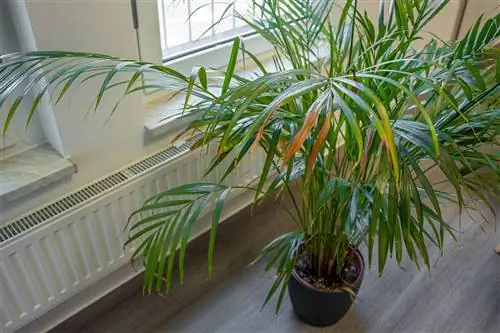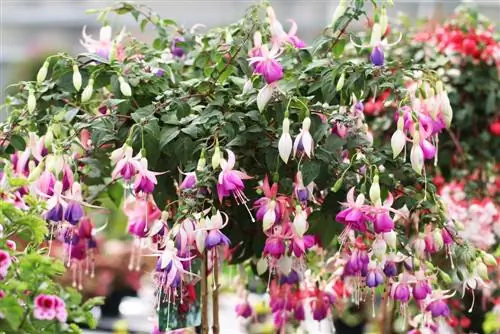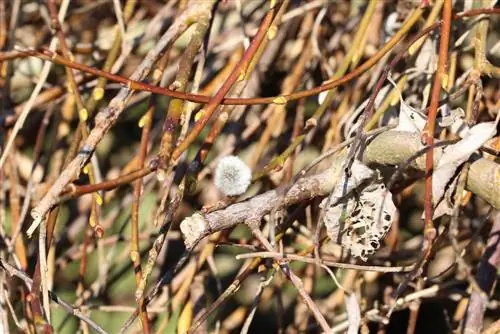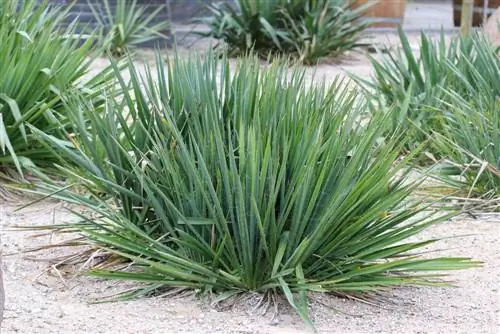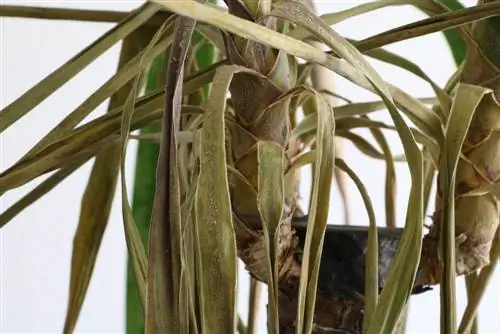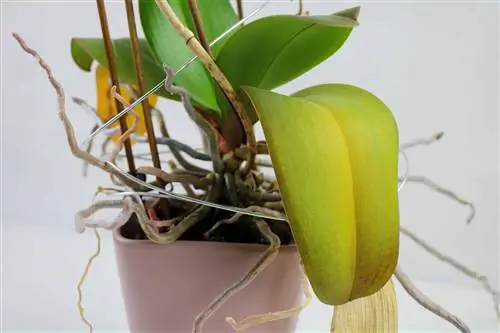- Author admin [email protected].
- Public 2023-12-17 03:39.
- Last modified 2025-01-24 12:45.
Palm trees give the home a southern flair. However, if Yucca & Co. leave their leaves hanging, their appearance is rather bleak. The causes of the hanging palm fronds are different. But a rescue attempt is definitely worth it.
Palm trees
Palm plants, known as palms for short, are a family of plants that includes 183 genera with approximately 2,600 species. Popular indoor palms include:
- Mountain Palm (Chamaedorea)
- Gold Fruit Palm (Dypsis lutescens)
- Kentia palm (Howea)
- Hollow palm (Rhapis excelsa)
- Washington palm (Washingtonia filifera and robusta)
- Dwarf date palm (Phoenix roebelenii)
- Dwarf palm (Chamaerops humilis)
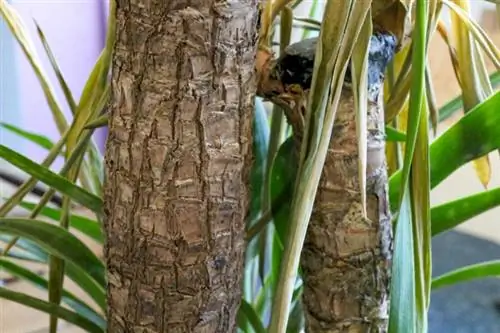
Note:
The Yucca palm is not a member of the palm family (Arecaceae). It is a representative of the palm lilies (Yucca), which belong to the Asparagales plant family. However, since its appearance is reminiscent of a palm tree, the German name Yucca palm has become common.
Causes
Despite the many types of palm trees, the causes of hanging fronds on indoor palms are very similar. Palm trees let their leaves hang because they are under
- Wetness,
- Drought,
- Nutrient deficiency,
- humidity that is too low or
- suffer from poor lighting conditions.
Wetness
Mushy and wet substrate cause the roots to rot. Since water can no longer be transported upwards, the palm leaves its leaves hanging. In order to clarify waterlogging as the cause, you should first reconsider your watering behavior. You can get concrete evidence by digging deep into the substrate at the edge of the pot and checking the moisture. If it is completely wet, the palm must be repotted immediately into dry soil. To save the plant, do the following:
- Carefully lift the indoor palm out of the pot
- Remove the root ball from the substrate
- cut off rotten roots
- Clean remaining roots with lukewarm water
- let it dry well
- Place palm tree in fresh, dry substrate
- do not water
Tip:
If a new pot is not available, you can reuse the old planter if it has at least one drainage hole. To prevent further rot, the container must be cleaned with hot water.
drought
Although palm trees tolerate dryness better than wetness, their leaves droop when there is a lack of water. In order for the houseplant to recover, you should proceed as follows for smaller specimens:
- fill larger container with lukewarm water
- The pot of the palm tree must fit in it
- If necessary, lift the indoor palm out of the planter
- put in the water
- take out when no more bubbles appear
- drain
- return to your usual location
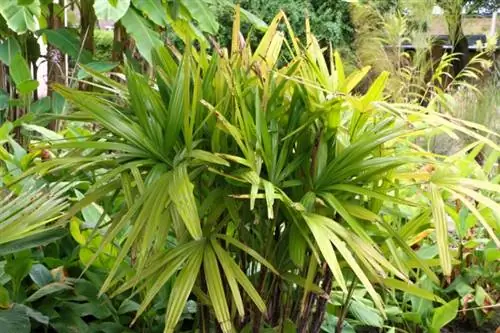
Note:
Since the dipping method is no longer possible with large palm trees, these indoor palms must be watered immediately in dry conditions.
Nutrient Deficiency
You can recognize nutrient deficiencies particularly well on newly growing leaves. If these hang limply, the palm tree needs more nutrients. To save the plant, fertilize it immediately with a liquid fertilizer for green plants. After a few weeks the indoor palm should have recovered.
Humidity too low
Palm trees that come from subtropical regions can suffer from low humidity in winter. They especially let their leaves hang when they are close to the heater. If the indoor palm cannot be moved, increase the humidity at the location:
- Place a bowl of water and pebbles right next to the palm tree
- Spray leaves with lime-free water
Unfavorable lighting conditions
Palm trees are often given a sunny location. However, not all species tolerate full sun and their leaves droop if there is too much sun. Examples of indoor palms that prefer a sunny or semi-shady place include:
- Mountain Palm
- Gold Fruit Palm
- Kentia Palm
- Yucca
Pests
Pests can also be the reason for the leaves hanging. Spider mites, thrips, scale insects or the red spider usually appear. Especially in winter, due to dry heating air and unfavorable conditions, indoor palms are more susceptible to pests. If you discover an infestation, you should act quickly. Simple home remedies and rinsing the plant are usually enough. You should often apply a wash solution made of water, oil and dishwashing liquid in a spray bottle to the affected palm trees.
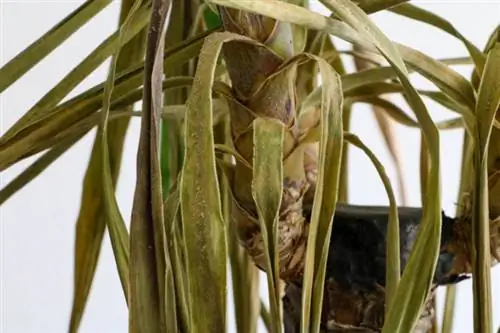
Frequently asked questions
Can repotting cause drooping leaves?
Although indoor palms require a new planter every few years, repotting them causes a lot of stress. If they are then too sunny, the palm trees often let their leaves droop. To help the plants cope with stress, place them in partial shade for the first two to three weeks after repotting.
Does drafts damage my yucca palm?
Yucca palms do not like sudden temperature differences. If you leave the leaves hanging in winter, you should check whether your yuccas are exposed to cold drafts - for example from a window that is opened for ventilation. A change of location can help. Alternatively, you should open another window to ventilate.

